�
Advanced Information and Knowledge Processing
Series Editors
Professor Lakhmi Jain
Lakhmi.jain@unisa.edu.au
Professor Xindong Wu
xwu@cs.uvm.edu
For other titles published in this series, go to
http://www.springer.com/4738
Michel Chein Marie-Laure Mugnier
Graph-based
Knowledge
Representation
Computational Foundations of Conceptual Graphs
�
Michel Chein
Laboratory of Informatics, Robotics, and
Micro-electronics (LIRMM)
FRANCE
Marie-Laure Mugnier
Laboratory of Informatics, Robotics, and
Micro-electronics (LIRMM)
FRANCE
AI&KP ISSN 1610-3947
ISBN: 978-1-84800-285-2
DOI 10.1007/978-1-84800-286-9
e-ISBN: 978-1-84800-286-9
British Library Cataloguing in Publication Data
A catalogue record for this book is available from the British Library
Library of Congress Control Number: 2008937554
c Springer-Verlag London Limited 200
9
Apart from any fair dealing for the purposes of research or private study, or criticism or review, as per-
mitted under the Copyright, Designs and Patents Act 1988, this publication may only be reproduced,
stored or transmitted, in any form or by any means, with the prior permission in writing of the publish-
ers, or in the case of reprographic reproduction in accordance with the terms of licences issued by the
Copyright Licensing Agency. Enquiries concerning reproduction outside those terms should be sent to
the publishers.
The use of registered names, trademarks, etc. in this publication does not imply, even in the absence of a
specific statement, that such names are exempt from the relevant laws and regulations and therefore free
for general use.
The publisher makes no representation, express or implied, with regard to the accuracy of the information
contained in this book and cannot accept any legal responsibility or liability for any errors or omissions
that may be made.
Printed on acid-free paper
9 8 7 6 5 4 3 2 1
Springer Science+Business Media
springer.com
�
Preface
This book provides a definition and study of a knowledge representation and rea-
soning formalism stemming from conceptual graphs, while focusing on the compu-
tational properties of this formalism.
Knowledge can be symbolically represented in many ways. The knowledge
representation and reasoning formalism presented here is a graph formalism –
knowledge is represented by labeled graphs, in the graph theory sense, and rea-
soning mechanisms are based on graph operations, with graph homomorphism at
the core.
This formalism can thus be considered as related to semantic networks. Since
their conception, semantic networks have faded out several times, but have always
returned to the limelight. They faded mainly due to a lack of formal semantics and
the limited reasoning tools proposed. They have, however, always rebounded be-
cause labeled graphs, schemas and drawings provide an intuitive and easily under-
standable support to represent knowledge.
This formalism has the visual qualities of any graphic model, and it is logically
founded. This is a key feature because logics has been the foundation for knowledge
representation and reasoning for millennia. The authors also focus substantially on
computational facets of the presented formalism as they are interested in knowledge
representation and reasoning formalisms upon which knowledge-based systems can
be built to solve real problems. Since object structures are graphs, naturally graph
homomorphism is the key underlying notion and, from a computational viewpoint,
this moors calculus to combinatorics and to computer science domains in which the
algorithmic qualities of graphs have long been studied, as in databases and constraint
networks.
The main notions are intuitively introduced from a knowledge representation
viewpoint, but the authors have also tried to give precise definitions of these no-
tions along with complete proofs of the theorems (readers only require a few simple
mathematical notions, which are summarized in the appendix).
This book does not present a methodology for knowledge representation nor de-
scribe actual applications (except for one chapter) or software tools. It presents the-
oretical bases that merge numerous previous studies carried out in the conceptual
v
�
vi
Preface
graph domain since Sowa’s seminal book and links basic reasoning issues to other
fundamental problems in computer science.
In a nutshell, the authors have attempted to answer the following question: “How
far is it possible to go in knowledge representation and reasoning by representing
knowledge with graphs (in the graph theory sense) and reasoning with graph oper-
ations?”
Organization
The book is divided into 3 parts, 13 chapters and 1 appendix.
The first part is devoted to the kernel of the formalism. In Chap. 2, Basic concep-
tual Graphs (BGs) are defined. BGs are structured by a subsumption relation defined
by the homomorphism notion between BGs, as well as by elementary specialization
and generalization operations. In Chap. 3, Simple conceptual Graphs (SGs) are in-
troduced. SGs can be sketchily defined as BGs augmented with equality. Chapter 4
is devoted to set and FOL semantics for SGs. The soundness and completeness
of homomorphism with respect to entailment relation and FOL deduction is proven.
Chapter 5 relates BG homomorphism with homomorphisms of other structures (e.g.,
hypergraphs, relational structures, conjunctive database queries) and solving a con-
straint network.
The second part develops computational aspects of basic conceptual graphs.
Chapters 6, and 7 are devoted to algorithms for BG homomorphism. Chapter 8
presents other specialization and generalization operations that are not covered in
the first part, e.g., least generalization, maximal join and other extended joins.
The third part pools the kernel extensions. All of these extensions are provided
with logically sound and complete reasoning mechanisms based on graph homo-
morphism. Chapter 9 focuses on nested conceptual graphs, which are hierachically
structured graphs. In Chap. 10, the important rule notion, which allows representa-
tion of implicit knowledge, for instance, is studied. The introduction of rules gives
the powerfulness of a computability model to the formalism. Positive and negative
constraints are considered in Chap. 11, and the BG family of models, combining
facts, rules and constraints, is presented. Chapter 12 is devoted to negation in con-
ceptual graphs. The last chapter presents semantic annotations—a currently favored
and potentially fruitful application.
Finally, the Appendix summarizes the basic mathematical notions used in the
book.
Each chapter begins with an overview of its content. It ends with bibliographical
notes devoted mainly to studies in the conceptual graph domain. Concerning the
references, the authors chose to cite studies from other domains throughout the text
and provide the conceptual graph references in the bibliographical notes.
�
Preface
Implementation
vii
This book is about a KR formalism that can serve as a theoretical foundation for
knowledge-based systems. A distinction is made between a KR formalism (e.g., a
fragment of first order logic) and a KR programming language (e.g., PROLOG).
Even when a KR programming language is based on a KR formalism, the KR lan-
guage presents variations to the KR formalism (limitations, e.g., Horn clauses or ex-
tensions, second order features, etc.), and it has a concrete syntax, contains specific
programming constructs (e.g., the cut in PROLOG) and is equipped with software
tools. Between a KR formalism and a programming language implementing this
formalism, there may be KR tools and platforms. This is the current situation of the
graph-based KR formalism presented in the book. CoGITaNT [cog01a] contains
a library of C++ classes that implement most of the notions and reasoning mecha-
nisms presented here. CoGITaNT also contains a graphical interface and a client–
server architecture. CoGITaNT thus allows a programmer to build knowledge-based
systems grounded on the formalism presented in this book. Let us also mention
COGUI
[cog01b], a graphical user interface dedicated to the construction of a
knowledge base and which integrates CoGITaNT.
Audience
The book is intended for computer science students, engineers and researchers.
Some of the materials presented in this book have been used for several years at
different academic levels, ranging from AI courses for graduate students to pro-
fessional and research master’s level courses. The mathematical prerequisites are
minimal, and the Appendix outlines the mathematical notions used in the book.
Here are some suggestions for reading paths of this book depending on readers’
specific interests.
Chapter 1 (introduction), Chap. 2 (basic conceptual graphs), Chap. 3 (simple con-
ceptual graphs), the two first sections of Chap. 4 (set and first order logic semantics)
are the core chapters and should be considered as the basis.
For programming and algorithmic purposes the following materials can be added
to the base: Chap. 6 (basic algorithms for BG homomorphism), the last section
of Chap. 5 (relationships with constraint programming techniques), Chap. 7 (tech-
niques for trees and other tractable cases), Chap. 8 (algorithms for other specializa-
tion/generalization operations, especially maximal joins), Chap. 10 (rule process-
ing), and Chap. 12 (algorithms for processing BGs with atomic negation).
For modeling purposes the following parts can be added to the base: Chap. 9
(nested conceptual graphs), Chap. 10 (definition and use of rules), Chap. 11 (defi-
nition and use of constraints and their combination with rules), Chap. 12 (definition
and use of atomic negation) and Chap. 13 (semantic annotations).
For more theory-oriented readers, expressivity, decidability and complexity re-
sults, as well as stating equivalence with problems of other domains, are presented
throughout the book, except in the last chapter.
�
viii
Acknowledgments
Preface
We are indebted to John Sowa, who is the founding father of conceptual graphs, and
the present book would not have existed without his pioneering work [Sow84].
We began working on conceptual graphs in 1992, and over the years many of our
colleagues and students have contributed, in one way or another, to this work.
We would like to thank:
Friends and colleagues who have supported our approach over the years: Franz
Baader, Marie-Christine Rousset, Pierre Marquis, Fritz Lehmann, Daniel Kayser,
Michel Habib, Guy Chaty;
Colleagues or students with whom we have directly collaborated on topics cov-
ered in this book: Jean-Franc¸ois Baget, Boris Carbonneill, Olivier Cogis, David
Genest, Olivier Guinaldo, Ollivier Haemmerl´e, Gwen Kerdiles, Michel Lecl`ere,
Anne Preller, Eric Salvat, Genevi`eve Simonet, Rallou Thomopoulos;
Colleagues from the conceptual graph community with whom we have had fruit-
ful discussions: Tru Cao, Fritjof Dau, Gerard Ellis, Jean Fargues, Bikash Gosh,
Fritz Lehmann, Robert Levinson, Dickson Lukose, Guy Mineau, John Sowa, Mark
Willems, Vilas Wuwongse.
Our approach has benefited from numerous collaborations on applied research
projects, and we would like to thank: Christian Baylon, Alain Bonnet, Bernard
Botella, Olivier Corby, Patrick Courounet, Rose Dieng, Steffen Lalande, Philippe
Martin, Patrick Taillibert.
We acknowledge Jean-Franc¸ois Baget, David Genest, Alain Gutierrez, Michel
Lecl`ere, Khalil Ben Mohamed, Nicolas Moreau, Fatiha Sa¨ıs, Eric Salvat, who re-
viewed parts of this book, with special thanks to Genevi`eve Simonet (some of her
comments could be the seeds for a new book ...).
We would also like to thank David Manley for rectifying our Franglais and Bev-
erley Ford and her team at Springer London for their support.
Obviously, all remaining errors are our fault alone. We welcome corrections and
suggestions on all aspects of the book; please send these to us at:
Michel.Chein@lirmm.fr and Marie-Laure.Mugnier@lirmm.fr. A web site compan-
ion to the book can also be queried at:
http://www.lirmm.fr/gbkrbook
La Boissi`ere,
Michel Chein and Marie-Laure Mugnier
March 2008
�
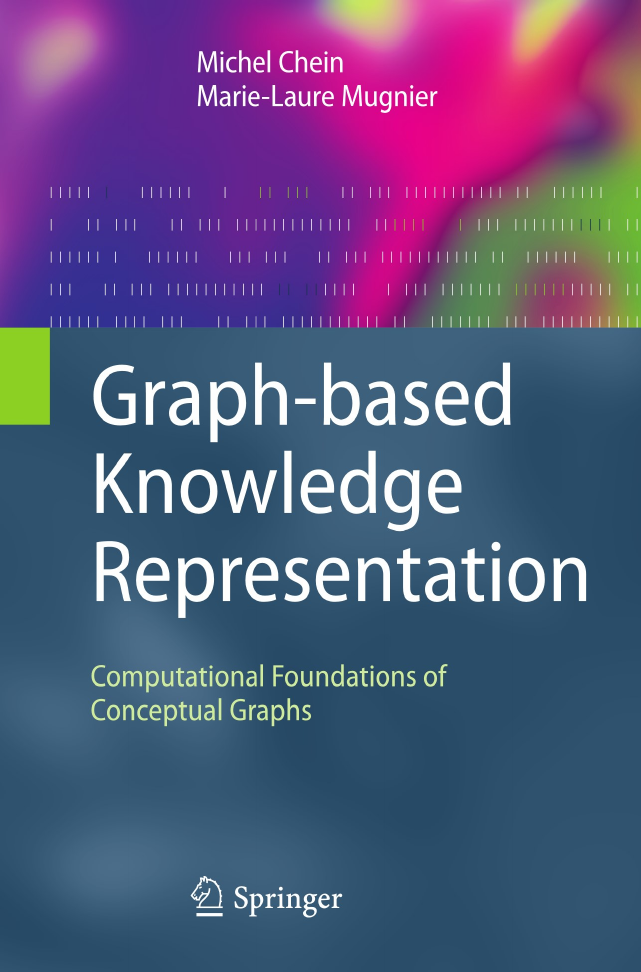

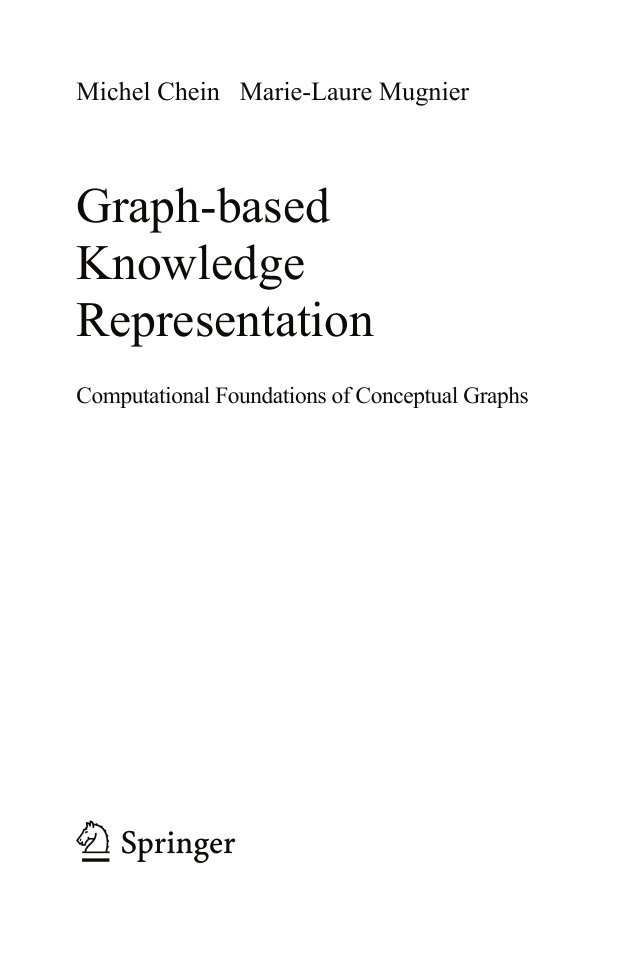
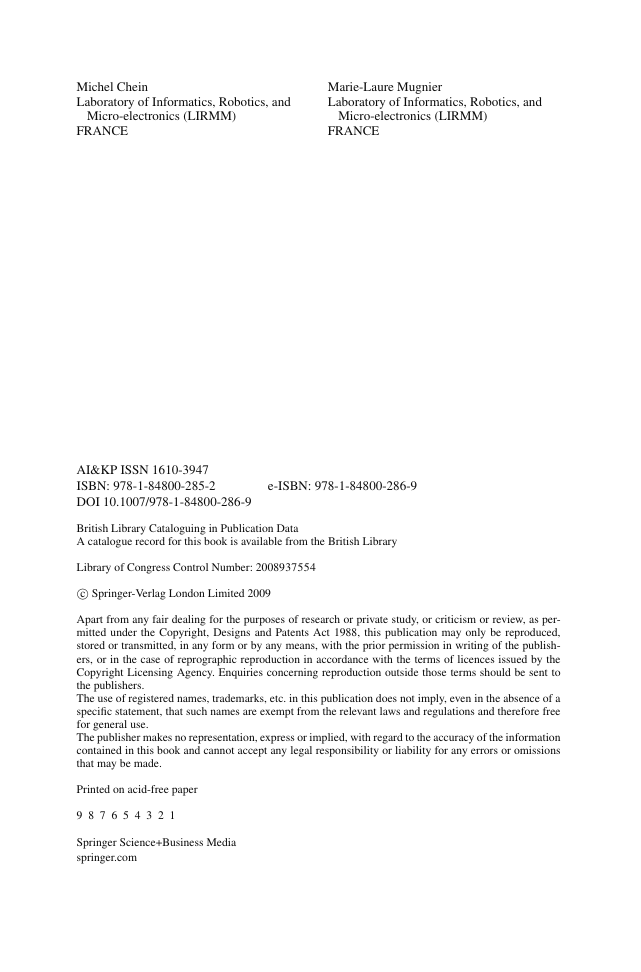
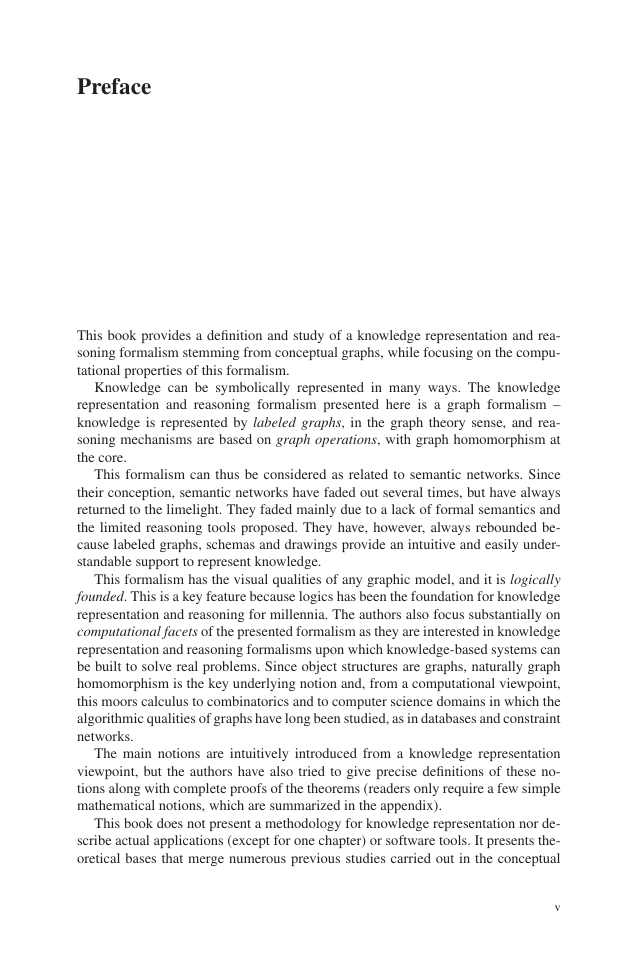
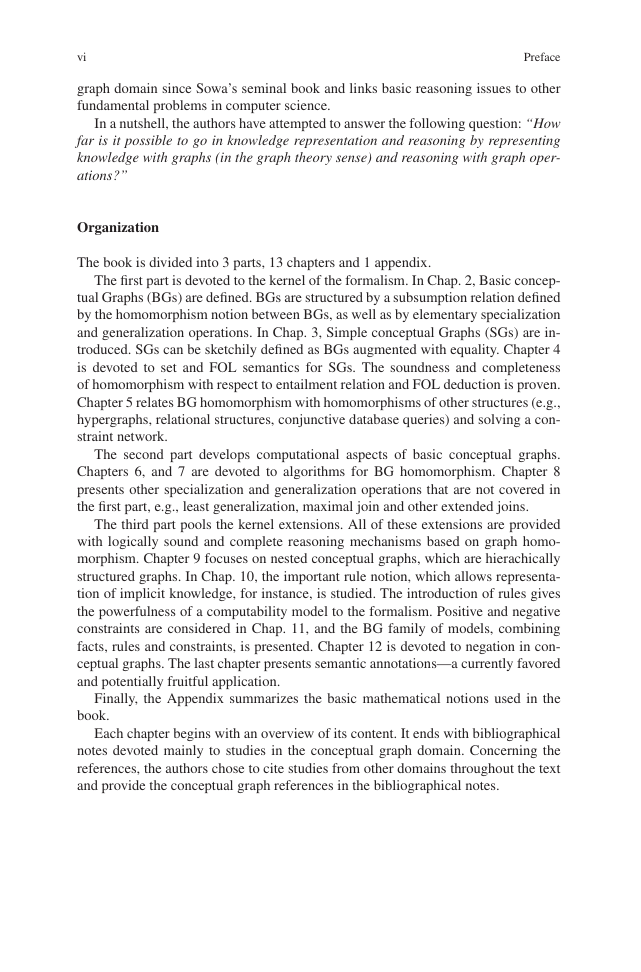
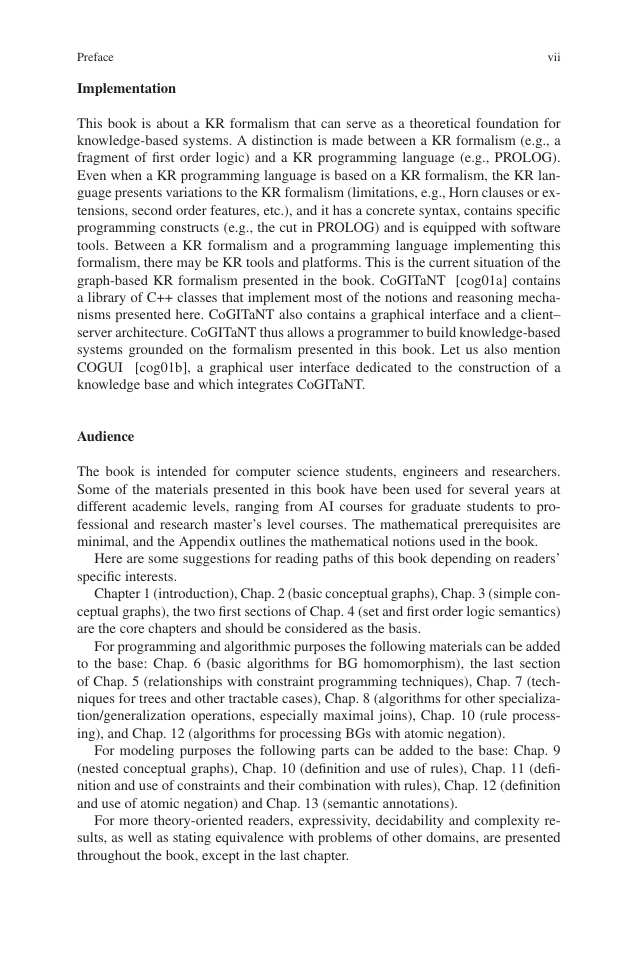
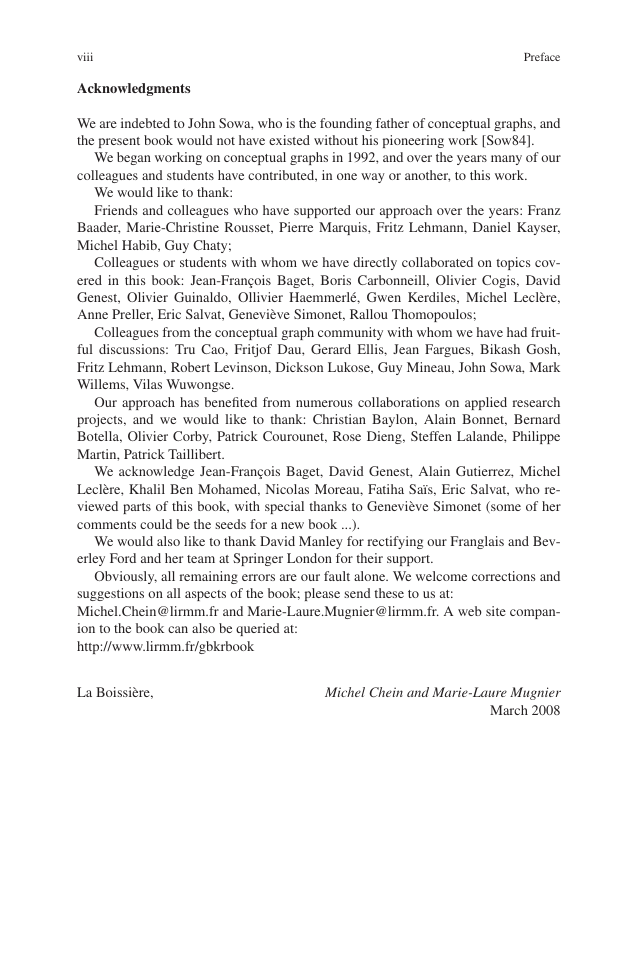








 2023年江西萍乡中考道德与法治真题及答案.doc
2023年江西萍乡中考道德与法治真题及答案.doc 2012年重庆南川中考生物真题及答案.doc
2012年重庆南川中考生物真题及答案.doc 2013年江西师范大学地理学综合及文艺理论基础考研真题.doc
2013年江西师范大学地理学综合及文艺理论基础考研真题.doc 2020年四川甘孜小升初语文真题及答案I卷.doc
2020年四川甘孜小升初语文真题及答案I卷.doc 2020年注册岩土工程师专业基础考试真题及答案.doc
2020年注册岩土工程师专业基础考试真题及答案.doc 2023-2024学年福建省厦门市九年级上学期数学月考试题及答案.doc
2023-2024学年福建省厦门市九年级上学期数学月考试题及答案.doc 2021-2022学年辽宁省沈阳市大东区九年级上学期语文期末试题及答案.doc
2021-2022学年辽宁省沈阳市大东区九年级上学期语文期末试题及答案.doc 2022-2023学年北京东城区初三第一学期物理期末试卷及答案.doc
2022-2023学年北京东城区初三第一学期物理期末试卷及答案.doc 2018上半年江西教师资格初中地理学科知识与教学能力真题及答案.doc
2018上半年江西教师资格初中地理学科知识与教学能力真题及答案.doc 2012年河北国家公务员申论考试真题及答案-省级.doc
2012年河北国家公务员申论考试真题及答案-省级.doc 2020-2021学年江苏省扬州市江都区邵樊片九年级上学期数学第一次质量检测试题及答案.doc
2020-2021学年江苏省扬州市江都区邵樊片九年级上学期数学第一次质量检测试题及答案.doc 2022下半年黑龙江教师资格证中学综合素质真题及答案.doc
2022下半年黑龙江教师资格证中学综合素质真题及答案.doc